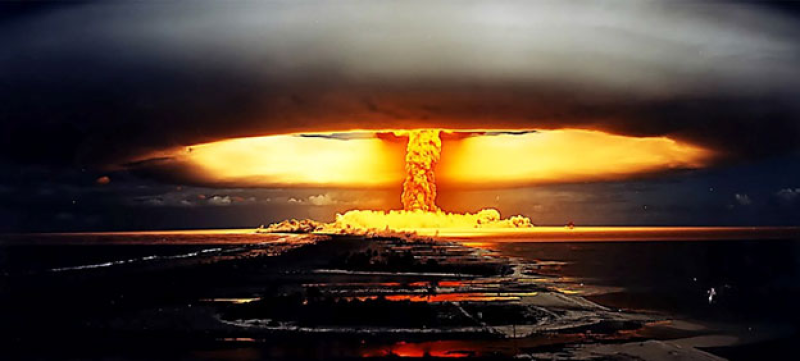- Tarique Calls for United Effort to Build a Safe Bangladesh |
- Tarique leaves for 300 feet area from airport |
- BNP top leaders welcome Tarique Rahman on homecoming |
- Flight carrying Tarique, family lands in Dhaka |
- Red bus with ‘Bangladesh first’ slogan ready at Dhaka airport for Tarique |
Nuclear Testing Threats Return as UN Chief Warns

A nuclear test is carried out on an island in French Polynesia in 1971.
Is the unpredictable Trump administration toying with the idea of resuming nuclear tests?
The New York Times reported on April 10 that some of Trump’s senior advisers had proposed resuming “test detonations for the sake of national security.” The last such US explosion took place in 1992.
Former US Representative Brandon Williams (Republican-New York), now administrator of the National Nuclear Security Administration (NNSA), which plays an integral role in the nation’s $1.7 trillion nuclear weapons modernization effort, testified before the Senate Armed Services Committee last April that he would not recommend restarting nuclear weapons testing.
The last confirmed full-scale nuclear explosive test was conducted by North Korea in September 2017, with perhaps more to come.
Speaking at a September 26 meeting on “the International Day for the Total Elimination of Nuclear Weapons,” UN Secretary-General Antonio Guterres warned, “Nuclear testing threats are returning, while nuclear saber rattling is louder than in past decades.”
Hard-won progress—reductions in arsenals and the cessation of testing—is being undone before our eyes. “We are sleepwalking into a new nuclear arms race,” Guterres said.
“I call on every State to ratify the Comprehensive Nuclear-Test-Ban Treaty, ending once and for all the dark legacy of nuclear tests. And every State must support the victims of nuclear use and testing, and confront the enduring harm: poisoned lands, chronic illness, and lasting trauma,” he added.
The devastating after-effects of past nuclear tests are still evident. During British nuclear weapons tests in Australia between 1952 and 1963, Indigenous voices were systematically ignored, resulting in severe health and cultural devastation, according to published reports.
Through decades of relentless campaigning, survivors and their descendants have forced official acknowledgement of the harm caused. Yet the fight for full justice continues, with many voices still unheard. Aboriginal communities reported severe health issues such as rashes, blindness, and cancers. A 1956 letter from an Australian government scientist mocked a patrol officer for prioritizing the safety of a “handful of natives” over the British Commonwealth.
Despite state-sanctioned ignorance, Aboriginal survivors and their advocates ensured their experiences were recognized.
Dr. M.V. Ramana, Professor and Simons Chair in Disarmament, Global and Human Security at the University of British Columbia, told IPS that a US resumption of nuclear weapons testing would likely prompt other countries—such as Russia, China, India, and North Korea—to test their nuclear weapons.
“This would accelerate a nuclear arms race and increase the likelihood of nuclear weapons use somewhere in the world, with catastrophic consequences,” he said. Even without nuclear war, communities near test sites—often including indigenous populations—will continue to suffer from radioactive contamination and other environmental effects.
“The only countervailing force is the peace and disarmament movement, which might catalyze public opposition to testing,” Dr. Ramana added.
Jackie Cabasso, Executive Director of the Western States Legal Foundation, said it was somewhat reassuring that Brandon Williams, during his confirmation hearings, stated he would advise against resuming explosive nuclear tests.
“However, Project 2025 proposes that a second Trump administration prioritize nuclear weapons programs, accelerate the development and production of all nuclear weapons, and prepare to test new nuclear weapons,” she said. Robert O’Brien, Trump’s national security advisor during his first term, wrote in Foreign Affairs that the U.S. should resume nuclear testing to counter China and Russia’s continued investments in nuclear arsenals.
Since 1945, at least eight countries have conducted 2,056 nuclear weapons tests. The United States conducted 1,030 of these in the atmosphere, underwater, and underground, while the USSR carried out 715. Most tests took place on lands of indigenous and colonized peoples.
“Not only did these nuclear test explosions fuel the development and spread of nuclear weapons, but hundreds of thousands have died and millions more have suffered from illnesses directly related to radioactive fallout in the US, Pacific islands, Australia, China, Algeria, Russia, Kazakhstan, India, Pakistan, North Korea, and elsewhere,” Cabasso said.
Major test sites include:
Nevada Test Site, USA
Pacific Proving Grounds, Marshall Islands
Semipalatinsk Test Site, Kazakhstan
Novaya Zemlya, Russia
Lop Nor, China
Reggane and Ekker, Algeria; Mururoa and Fangataufa atolls, French Polynesia
Maralinga, Emu Field, and Montebello, Australia
Environmental and health effects include global radioactive fallout, increased cancer rates, acute radiation sickness, soil and water contamination, ecosystem disruption, psychological trauma, and ongoing compensation challenges for “Downwinders” in the US.
This article is brought to you by IPS NORAM, in collaboration with INPS Japan and Soka Gakkai International, in consultative status with the UN’s Economic and Social Council (ECOSOC).

